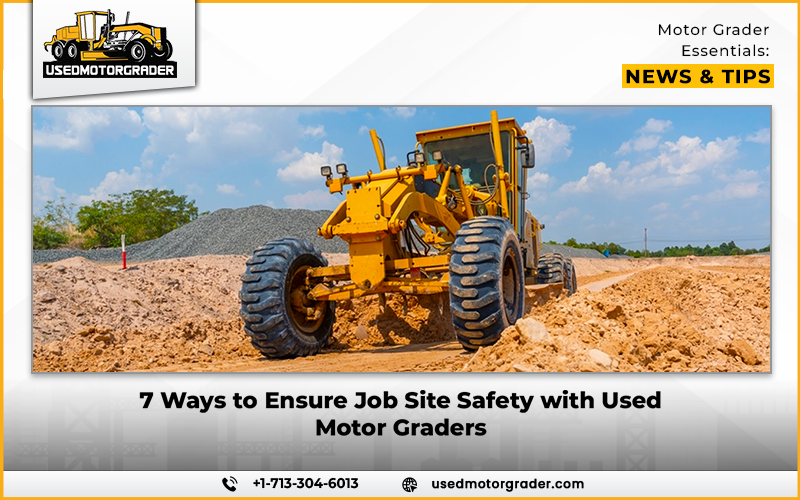Safety is one of the most important considerations on any construction site. With large, powerful machines in constant motion, the risk of accidents can never be underestimated. This is even more important when operating used motor graders, which may not have the same cutting-edge safety features as newer models but are still competent machines. By following consistent safety practices, companies can ensure the safety of their workers and equipment, while also maintaining productivity.
1. Conduct Thorough Pre-Operation Inspections
The first step in job site safety begins before the machine even moves. Used equipment can be just as reliable as new, if properly inspected and maintained, but skipping checks creates unnecessary risks. Operators should always:
- Check fluid levels (engine oil, hydraulic fluid, coolant).
- Inspect tires, brakes, and steering components.
- Check that lights, alarms, and safety signals are working.
- Identify any leaks, cracks, or wear before use.
A quick walkaround and inspection can identify problems that may cause breakdowns or accidents if left unaddressed. This proactive habit keeps graders prepared for safe operation.
2. Train Operators for Safe Handling
Even the best equipment is not safe in untrained hands. Operators of used motor graders should not only be licensed but also trained to operate the specific model of grader they will be using. Training should be in safe handling and emergency preparedness. Companies should:
- Make sure operators are properly licensed and certified.
- Provide training on the specific model of used motor grader.
- Stress emergency response procedures.
- Encourage refresher courses to keep up with skills.
Well-trained operators minimize the likelihood of accidents and help prolong the life of the equipment by using it properly.
3. Maintain Clear Communication on the Job Site
With multiple pieces of heavy equipment in motion, clear communication is a safety lifeline. When graders are in use, all workers must know their positions and movements. This is particularly important for older graders, who might not have advanced collision avoidance systems. Good communication involves:
- Using radios or hand signals to coordinate.
- Establishing designated areas for equipment and personnel.
- Keeping spotters available when working in tight areas.
- Creating a culture in which workers report hazards immediately.
When everyone on the site communicates clearly, the risks of missteps and collisions are greatly reduced.
4. Follow Proper Operating Practices
Safe operating practices should be a non-negotiable standard. Graders are designed for certain capacities and conditions, and pushing them beyond limits often results in accidents. Operators should:
- Avoid excessive speeds on uneven or loose ground.
- Keep blade adjustments smooth so as not to strain the equipment.
- Never overload the grader more than it is designed for.
- Keep a safe distance from other equipment and workers.
By respecting both the machine’s capabilities and job site conditions, operators are protecting themselves, others, and the grader.
5. Prioritize Equipment Maintenance
Safety and maintenance go hand in hand, especially for used machinery. While inspections catch immediate issues, ongoing servicing prevents long-term issues that could put operators at risk. Good maintenance practices include:
- Scheduling routine servicing and preventive maintenance.
- Replacing worn-out parts before they cause accidents.
- Keeping detailed maintenance logs for reference.
- Addressing small issues immediately to avoid bigger risks.
Well-maintained graders not only work more safely, but they also perform better on the job.
6. Use Safety Enhancements and Modern Technology
One of the benefits of today’s market is that you can retrofit older equipment with modern safety upgrades. Even if a grader isn’t equipped with the latest features from the factory, it can be enhanced to meet higher safety standards. Companies should consider:
- Equipping graders with back-up cameras or proximity sensors.
- Installing ROPS (Roll-Over Protective Structures) if not present.
- Using telematics to monitor performance and maintenance requirements.
- Upgrading lighting systems for night operations.
These upgrades offer peace of mind and enhance worker protection, even on older machines.
7. Encourage a Safety-First Job Site Culture
Safety cannot just be a checklist; it has to be part of the workplace culture. From operators to supervisors, everyone on site should appreciate safe practices. Building this culture includes:
- Conducting regular toolbox talks on safety practices.
- Rewarding compliance and safe behavior
- Encouraging workers to speak up about unsafe conditions.
- Making safety protocols part of daily operations, not just checklists.
When safety is second nature, the entire site runs more smoothly and more efficiently.
In the End
Used motor graders continue to be an essential part of many job sites thanks to their reliability and cost-effectiveness. But safety should always be first. Through careful inspections, adequate training, effective communication, and regular maintenance, these machines can be just as safe as new machines. Adding modern safety upgrades and fostering a culture of responsibility only helps to protect more. In the end, job site safety is about people-and keeping them safe ensures projects are not only successful, but sustainable in the long run.
FAQs
Q1. Why is safety more important when using used motor graders?
A: Used graders may not have some of the modern safety technologies, so operators must rely more on inspections, training, and job site protocols to ensure safe operation.
Q2. How often should used motor graders be inspected for safety?
A: Experts recommend daily inspections before each shift and regular servicing based on hours of use and manufacturer guidelines.
Q3. What are the best technologies to improve grader safety?
A: Backup cameras, ROPs, telematics systems, and upgraded lighting are some of the best improvements for older graders.
Q4. Can operator training reduce accidents with used graders?
A: Yes, trained operators know the limitations and the strengths of the machine and are much less likely to cause accidents.


